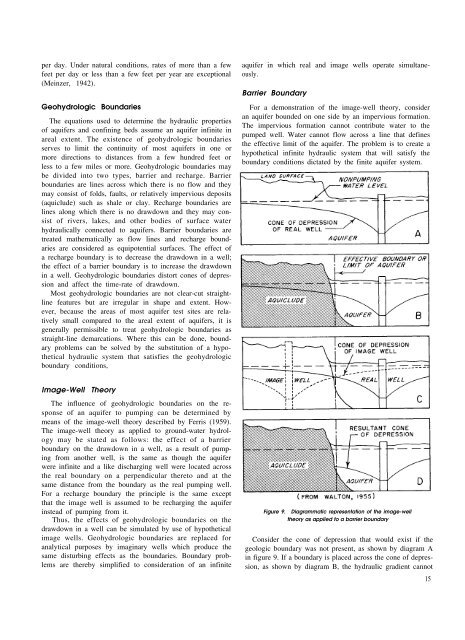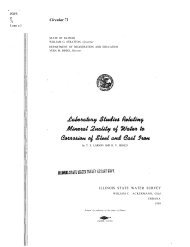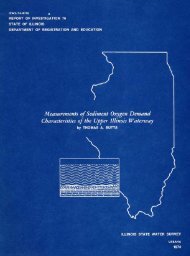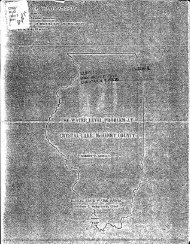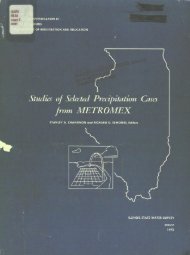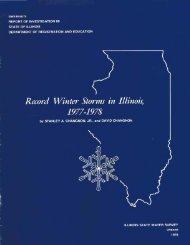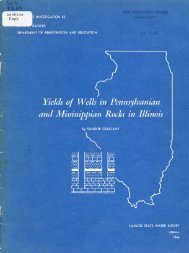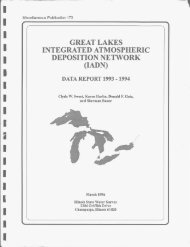it is required to estimate the range in productivity <strong>and</strong> relativeconsistency in productivity of the three units. Specificcapacities are divided by the total depths of penetration toobtain specific capacities per foot of penetration. <strong>Well</strong>s aresegregated into categories depending upon the units penetratedby wells. Specific capacities per foot of penetration<strong>for</strong> wells in each category are tabulated in order of magnitude,<strong>and</strong> frequencies are computed with the followingequation derived by Kimball (1946):F = [ m o / (n w +l)]l00 (34)where:m o = the order numbern w = total number of wellsF = percentage of wells whose specific capacities areequal to, or greater than, the specific capacity o<strong>for</strong>der number m oValues of specific capacity per foot of penetration are thenplotted against the percentage of wells on logarithmic probabilitypaper. Straight lines are fitted to the data.If specific capacities per foot of penetration decrease asthe depth of wells <strong>and</strong> number of units penetrated increase,the upper units are more productive than the lower units.Unit-frequency graphs can be constructed from the category-frequencygraphs by the process of subtraction, takinginto consideration uneven distribution of wells in the categories.The slope of a unit-frequency graph varies with theinconsistency of production, a steeper line indicating agreater range in productivity.Flow-Net AnalysisContour maps of the water table or piezometric surfacetogether with flow lines are useful <strong>for</strong> determining thehydraulic properties of aquifers <strong>and</strong> confining beds <strong>and</strong>estimating the velocity of flow of ground water. Flow lines,paths followed by particles of water as they move throughan aquifer in the direction of decreasing head, are drawn atright angles to piezometric surface or water-table contours.If the quantity of water percolating through a given crosssection (flow channel) of an aquifer delimited by two flowlines <strong>and</strong> two piezometric surface or water-table contours isknown, the coefficient of transmissibility can be estimatedfrom the following modified <strong>for</strong>m of the Darcy equation:T = Q /IL (35)where:Q = discharge, in gpdT = coefficient of transmissibility, in gpd/ftI = hydraulic gradient, in feet per mile (ft/mi)L = average width of flow channel, in miles (mi)L is obtained from the piezometric surface or water-tablemap with a map measurer. The hydraulic gradient can becalculated by using the following <strong>for</strong>mula (sec Foley, Walton,<strong>and</strong> Drescher, 1953):I = c / W a (36)where:I = hydraulic gradient, in ft/mi14c = contour interval of piezometric surface or watertablemap, in ft<strong>and</strong>W a = A’ /L (37)in which A’ is the area, in square miles, between twolimiting flow lines <strong>and</strong> piezometric surface or water-tablecontours; <strong>and</strong> L is the average length, in miles, of thepiezometric surface or water-table contours between thetwo limiting flow lines.If the quantity of leakage through a confining bed intoan aquifer, the thickness of the confining bed, area of confiningbed through which leakage occurs, <strong>and</strong> the differencebetween the head in the aquifer <strong>and</strong> in the source bed abovethe confining bed are known, the coefficient of vertical permeabilitycan be computed from the following modified<strong>for</strong>m of the Darcy equation:P' = Q c m’ /∆hA c (38)where:P’ = coefficient of vertical permeability of confining bed,in gpd/sq ftQ c = leakage through confining bed, in gpdm’ = thickness of confining bed through which leakageoccurs, in ftA c = area of confining bed through which leakage occurs,in sq ft∆h = difference between the head in the aquifer <strong>and</strong> inthe source bed above the confining bed, in ftThe velocity of the flow of ground water can be calculatedfrom the equation of continuity, as follows:V = Q /7.48S y A (39)where:V = velocity, in feet per day (fpd)Q = discharge, in gpdA = cross-sectional area of the aquifer, in sq ftS y = specific yield of aquifer, fractionThe specific yield converts the total cross-sectional areaof the aquifer to the effective area of the pore openingsthrough which flow actually occurs.The discharge Q can be calculated from Darcy’s equationas the product of the coefficient of permeability, hydraulicgradient, <strong>and</strong> cross-sectional area of aquifer or:Q = PIA (40)Substitution of equation 40 in equation 39 results in theexpression (see Butler, 1957):V = PI /7.48S y (41)where:V = velocity of flow of ground water, in fpdP = coefficient of permeability, in gpd/sq ftI = hydraulic gradient, in ft/ftS y = specific yield, fractionThe range in ground-water velocities is great. Underheavy pumping conditions, except in the immediate vicinityof a pumped well, velocities are generally less than 100 feet
per day. Under natural conditions, rates of more than a fewfeet per day or less than a few feet per year are exceptional(Meinzer, 1942).Geohydrologic BoundariesThe equations used to determine the hydraulic propertiesof aquifers <strong>and</strong> confining beds assume an aquifer infinite inareal extent. The existence of geohydrologic boundariesserves to limit the continuity of most aquifers in one ormore directions to distances from a few hundred feet orless to a few miles or more. Geohydrologic boundaries maybe divided into two types, barrier <strong>and</strong> recharge. Barrierboundaries are lines across which there is no flow <strong>and</strong> theymay consist of folds, faults, or relatively impervious deposits(aquiclude) such as shale or clay. Recharge boundaries arelines along which there is no drawdown <strong>and</strong> they may consistof rivers, lakes, <strong>and</strong> other bodies of surface waterhydraulically connected to aquifers. Barrier boundaries aretreated mathematically as flow lines <strong>and</strong> recharge boundariesare considered as equipotential surfaces. The effect ofa recharge boundary is to decrease the drawdown in a well;the effect of a barrier boundary is to increase the drawdownin a well. Geohydrologic boundaries distort cones of depression<strong>and</strong> affect the time-rate of drawdown.Most geohydrologic boundaries are not clear-cut straightlinefeatures but are irregular in shape <strong>and</strong> extent. However,because the areas of most aquifer test sites are relativelysmall compared to the areal extent of aquifers, it isgenerally permissible to treat geohydrologic boundaries asstraight-line demarcations. Where this can be done, boundaryproblems can be solved by the substitution of a hypotheticalhydraulic system that satisfies the geohydrologicboundary conditions,aquifer in which real <strong>and</strong> image wells operate simultaneously.Barrier BoundaryFor a demonstration of the image-well theory, consideran aquifer bounded on one side by an impervious <strong>for</strong>mation.The impervious <strong>for</strong>mation cannot contribute water to thepumped well. Water cannot flow across a line that definesthe effective limit of the aquifer. The problem is to create ahypothetical infinite hydraulic system that will satisfy theboundary conditions dictated by the finite aquifer system.Image-<strong>Well</strong> TheoryThe influence of geohydrologic boundaries on the responseof an aquifer to pumping can be determined bymeans of the image-well theory described by Ferris (1959).The image-well theory as applied to ground-water hydrologymay be stated as follows: the effect of a barrierboundary on the drawdown in a well, as a result of pumpingfrom another well, is the same as though the aquiferwere infinite <strong>and</strong> a like discharging well were located acrossthe real boundary on a perpendicular thereto <strong>and</strong> at thesame distance from the boundary as the real pumping well.For a recharge boundary the principle is the same exceptthat the image well is assumed to be recharging the aquiferinstead of pumping from it.Thus, the effects of geohydrologic boundaries on thedrawdown in a well can be simulated by use of hypotheticalimage wells. Geohydrologic boundaries are replaced <strong>for</strong>analytical purposes by imaginary wells which produce thesame disturbing effects as the boundaries. Boundary problemsare thereby simplified to consideration of an infiniteFigure 9. Diagrammatic representation of the image-welltheory as applied to a barrier boundaryConsider the cone of depression that would exist if thegeologic boundary was not present, as shown by diagram Ain figure 9. If a boundary is placed across the cone of depression,as shown by diagram B, the hydraulic gradient cannot15
- Page 1: BULLETIN 49STATE OF ILLINOISDEPARTM
- Page 4 and 5: PAGEModel aquifer and mathematical
- Page 6: ivFIGURE65 Model aquifers and mathe
- Page 9 and 10: Part 1. Analysis of Geohydrologic P
- Page 11 and 12: aquifers” (Hantush, 1956) and is
- Page 13 and 14: S y =P =m =application of the nonle
- Page 15 and 16: yond ln u becomes insignificant. Wh
- Page 18 and 19: point D(u) q , l/u², s, and t are
- Page 22 and 23: emain as it was because it would ca
- Page 25 and 26: The computed value of T and other k
- Page 27 and 28: part of 90°.” Under the foregoin
- Page 29 and 30: however, ground-water runoff under
- Page 31 and 32: the hydraulic properties of the aqu
- Page 33 and 34: Well LossThe components of drawdown
- Page 35 and 36: a screen and an optimum screen entr
- Page 37 and 38: Part 3. Illustrative Examples of An
- Page 39 and 40: properties of the aquifer and confi
- Page 41 and 42: downs in the observation wells were
- Page 43 and 44: Figure 33.Thickness of dolomite of
- Page 45 and 46: constructed with figure 34 by the p
- Page 47 and 48: increases in the yields of newly co
- Page 49 and 50: Effects of Acid TreatmentAcid treat
- Page 51 and 52: Coefficient of TransmissibilityThe
- Page 53 and 54: Formation, probably the least perme
- Page 55 and 56: of water levels after 53 hours of p
- Page 57 and 58: 45 and 46 were used to determine th
- Page 59 and 60: cross sections A—A' and B—B' is
- Page 61 and 62: water storage during 1951, 1952, an
- Page 63 and 64: and the coefficient of transmissibi
- Page 65 and 66: 200,000 gpd (Walker and Walton, 196
- Page 67 and 68: and the source of recharge is preci
- Page 69 and 70: gpd/ft and 410 gpd/sq ft, respectiv
- Page 71 and 72:
The test was started at 11:20 a.m.
- Page 73 and 74:
projects from the caisson at a dept
- Page 75 and 76:
ConclusionsIt is often possible to
- Page 77 and 78:
Hantush, M. S. 1957b. Preliminary q
- Page 79 and 80:
APPENDIX AVALUES OF W (u, r/B)r / B
- Page 81 and 82:
APPENDIX A (CONTINUED)VALUES OF W(u
- Page 83 and 84:
NAPPENDIX B (CONTINUED)VALUES OF Ko
- Page 85 and 86:
λr w/BAPPENDIX DVALUES OF G(λ, r
- Page 87:
APPENDIX FSelected Conversion Facto


